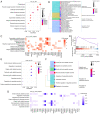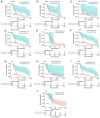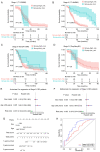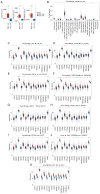A hot and cold tumor‑related prognostic signature for stage II colorectal cancer
- PMID: 39006949
- PMCID: PMC11240279
- DOI: 10.3892/ol.2024.14552
A hot and cold tumor‑related prognostic signature for stage II colorectal cancer
Abstract
Globally, colorectal cancer (CRC) is one of the most lethal and prevalent malignancies. Based on the presence of immune cell infiltration in the tumor microenvironment, CRC can be divided into immunologically 'hot' or 'cold' tumors, which in turn leads to the differential efficacy of immunotherapy. However, the immune characteristics of hot and cold CRC tumors remain largely elusive, prompting further investigation of their properties regarding the tumor microenvironment. In the present study, a predictive model was developed based on the differential expression of proteins between cold and hot CRC tumors. First, the differentially expressed proteins (DEPs) were identified using digital spatial profiling and mass spectrometry-based proteomics analysis, and the pathway features of the DEPs were analyzed using functional enrichment analysis. A novel eight-gene signature prognostic risk model was developed (IDO1, MAT1A, NPEPL1, NT5C, PTGR2, RPL29, TMEM126A and TUBB4B), which was validated using data obtained from The Cancer Genome Atlas. The results revealed that the risk score of the eight-gene signature acted as an independent prognostic indicator in patients with stage II CRC (T3-4N0M0). It was also found that a high-risk score in the eight-gene signature was associated with high immune cell infiltration in patients with CRC. Taken together, these findings revealed some of the differential immune characteristics of hot and cold CRC tumors, and an eight-gene signature prognostic risk model was developed, which may serve as an independent prognostic indicator for patients with stage II CRC (T3-4N0M0).
Keywords: colorectal cancer; hot and cold tumor; prognosis; tumor microenvironment.
Copyright: © 2024 Zhou et al.
Conflict of interest statement
The authors declare that they have no competing interests.
Figures






Similar articles
-
A novel oxidative stress- and ferroptosis-related gene prognostic signature for distinguishing cold and hot tumors in colorectal cancer.Front Immunol. 2022 Oct 31;13:1043738. doi: 10.3389/fimmu.2022.1043738. eCollection 2022. Front Immunol. 2022. PMID: 36389694 Free PMC article.
-
A novel anoikis-related gene prognostic signature and its correlation with the immune microenvironment in colorectal cancer.Front Genet. 2023 May 30;14:1186862. doi: 10.3389/fgene.2023.1186862. eCollection 2023. Front Genet. 2023. PMID: 37323657 Free PMC article.
-
Identification of prognostic immune-related gene signature associated with tumor microenvironment of colorectal cancer.BMC Cancer. 2021 Aug 8;21(1):905. doi: 10.1186/s12885-021-08629-3. BMC Cancer. 2021. PMID: 34364366 Free PMC article.
-
A novel prognostic model based on urea cycle-related gene signature for colorectal cancer.Front Surg. 2022 Oct 21;9:1027655. doi: 10.3389/fsurg.2022.1027655. eCollection 2022. Front Surg. 2022. PMID: 36338624 Free PMC article.
-
m5C regulator-mediated modification patterns and tumor microenvironment infiltration characterization in colorectal cancer: One step closer to precision medicine.Front Immunol. 2022 Dec 1;13:1049435. doi: 10.3389/fimmu.2022.1049435. eCollection 2022. Front Immunol. 2022. PMID: 36532062 Free PMC article.
Cited by
-
Development and validation of a prognostic model for colon cancer based on mitotic gene signatures and immune microenvironment analysis.Discov Oncol. 2024 Oct 9;15(1):535. doi: 10.1007/s12672-024-01421-2. Discov Oncol. 2024. PMID: 39382813 Free PMC article.
References
LinkOut - more resources
Full Text Sources
Research Materials
